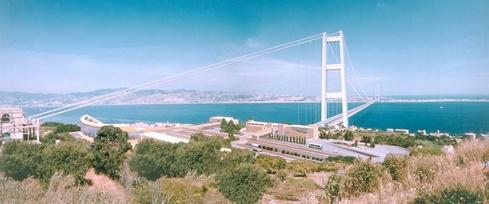Italy is aiming to classify the €13.5 billion Sicily bridge project as part of its defence expenditure in a bid to meet NATO’s defence spending targets, according to reports from Wanted in Rome. The ambitious infrastructure venture, officially known as the Strait of Messina Bridge, has long been a subject of national debate due to its scale and strategic importance. By reclassifying the project under defence spending, Italy seeks to bolster its contributions to the alliance’s 2% of GDP benchmark, amid increasing pressure to meet NATO commitments. This move highlights the intersection of national infrastructure development and international security obligations.
Italy’s Strategic Move to Include Sicily Bridge in Defence Budget Faces NATO Scrutiny
Italy’s ambitious attempt to categorize the €13.5 billion Sicily bridge project as part of its defence expenditure has sparked a wave of debate within NATO circles. The Italian government argues that the bridge, intended to drastically improve military logistics and troop mobility between mainland Italy and Sicily, aligns with NATO’s strategic priorities. By reclassifying this massive infrastructure project, Italy aims to push its defence spending closer to the alliance’s 2% of GDP target, amidst growing pressure from member states to enhance collective security commitments.
However, the move faces scrutiny from several NATO officials who question whether civilian infrastructure can legitimately qualify as military spending. Critics cite concerns over setting a precedent that could blur the lines of defence accounting across the bloc. Key points of contention include:
- Dual-use infrastructure: Whether the bridge’s role justifies classification as a defence asset due to its potential for rapid military deployment.
- Spending transparency: The risk of inflating defence budgets with projects primarily serving civilian purposes.
- Implications for NATO cohesion: Possible challenges this reclassification could pose for alliance-wide defence spending standards.
| Project Aspect | Italian Position | NATO Concerns |
|---|---|---|
| Strategic Value | Critical for troop movement | Primarily civilian use |
| Budget Impact | Helps meet 2% GDP target | Potential budget inflation |
| Precedent | Sets new classification guidelines | Muddles defence spending transparency |
Implications of Reclassifying Infrastructure Spending for Military Commitments
Reclassifying the €13.5 billion Sicily bridge as defence expenditure has sparked a complex debate surrounding the boundaries of NATO’s 2% GDP military spending benchmark. Italy’s move reflects a strategic interpretation of infrastructure projects as dual-use investments, potentially strengthening logistical and operational capabilities for military purposes. This approach, while financially efficient, raises questions about the precedent it sets for future budgetary classifications across member states and the true measurement of a nation’s defence commitments.
Critics argue that blurring the lines between civilian infrastructure and defence expenditure could dilute NATO’s spending standards, whereas proponents highlight key military advantages, such as:
- Enhanced mobility: Facilitating rapid troop deployment and supply transport across critical regions
- Strategic value: Improving connectivity in geopolitically sensitive areas like Sicily
- Cost-efficiency: Leveraging existing projects to meet alliance obligations without additional military outlays
| Aspect | Traditional Military Spending | Reclassified Infrastructure |
|---|---|---|
| Purpose | Direct combat readiness | Logistical support |
| Budget Impact | Explicit defence allocation | Indirect defence budget inflation |
| Transparency | Clear reporting standards | Potential scrutiny and debate |
Policy Recommendations for Balancing Economic Development and NATO Defence Obligations
Italy’s bold move to classify the €13.5 billion Sicily bridge project as part of its NATO defence expenditure underscores the increasing complexity of balancing national economic priorities with alliance commitments. Policymakers must establish clear criteria that differentiate genuine defence-related infrastructure from civilian projects to maintain transparency and credibility within NATO. This calls for robust frameworks that evaluate projects on parameters such as dual-use capabilities, strategic military logistics, and direct enhancement of rapid troop deployment abilities.
To effectively reconcile economic development with NATO defence obligations, a multi-layered policy approach can be adopted:
- Integrated Infrastructure Assessment: Regular audits by independent experts to verify the defence relevance of large-scale projects.
- Flexible Budget Allocation: Creating categories within defence spending that allow for investments in dual-purpose infrastructure without compromising NATO targets.
- Stakeholder Engagement: Collaboration between military strategists, economists, and regional planners to align objectives.
| Policy Measure | Primary Goal | Expected Outcome |
|---|---|---|
| Infrastructure Eligibility Criteria | Clear definition of defence asset inclusion | Enhanced NATO trust and compliance |
| Multi-sector Partnerships | Collaboration across government sectors | Balanced economic and strategic gains |
| Flexible Defence Budgeting | Allow investment in dual-use infrastructure | Optimized allocation without compromising NATO targets |
If you’d like, I can also help you improve the styling or add more content to the section. Let me know!
The Conclusion
As Italy navigates the complexities of meeting NATO’s defence spending targets, the proposal to classify the €13.5 billion Sicily bridge project under military expenditure highlights the challenges faced by member states in balancing infrastructure needs with alliance commitments. The outcome of this move will not only impact Italy’s standing within NATO but also set a precedent for how countries might approach defence budgeting in the future. Observers will be watching closely as Rome engages in discussions with Brussels and NATO officials to determine whether this controversial reclassification can withstand scrutiny and effectively contribute to alliance goals.




